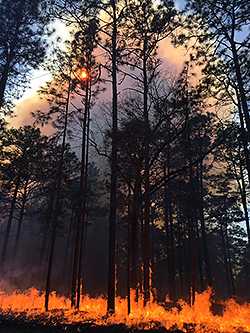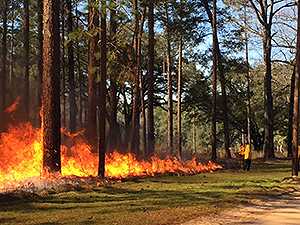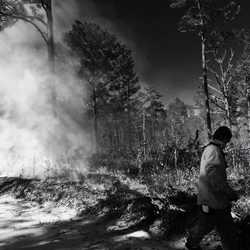Prescribed Fires and Air Quality
CDC & Forest Service Address Fires & Air Quality

Forest fire in a longleaf pine forest
NCEH Division of Environmental Hazards and Health Effects (EHHE) staff recently joined Forest Service staff and staff at the Joseph W. Jones Ecological Research Center at Ichauway in Newton, GA, to examine the importance of prescribed burns in forest management and the prevention of uncontrolled forest fire.
CDC, USFS, and Jones Center experts discussed wildfires, forest management, and the health effects of both planned and unplanned fire events. Smoke from wildfires—a mixture of gases and fine particles from burning trees and other materials—hurts the eyes, irritates the respiratory system, and worsens chronic heart and lung diseases. Smoke from wildfires can travel long distances, meaning that residual smoke can threaten the health of individuals living a significant distance from any wildfire.
During the Ichauway meeting, CDC staff learned about the challenges the Forest Service faces in the Southern Region, some potential human health implications of the urban-forest interface and smoke from wildfires and prescribed fires, and the value of forests for watershed protection and water quality.
Meeting attendees and Jones Center staff also conducted a small prescribed burn of about 20 acres of longleaf pine forest. CDC staff learned firsthand—and hands-on—how such burns are done, how often they are needed, and why Forest Service and Jones Center experts view them as appropriate for both air quality and forest health. Through the use of prescribed, or planned, burns the Forest Service and private landowners are able to prevent large, unplanned fires and thus control negative effects on air quality and water quality, as well as the need for emergency response.

Fire set by fire boss
Land managers use fire as a management tool through prescribed burns, as a number of forest ecosystems are dependent upon periodic fire. However, the human health effects from smoke make the planned use of fire more and more challenging as the rural landscapes continues to urbanize, not only in the Southeast, but nationwide.
EHHE staff shared some of the challenges CDC faces in working with fire and air quality issues. EHHE has worked with state health departments, EPA, and others over the last 20 years to provide assistance in assessing health impacts from wildfires, and has participated in development of a number of resource documents for public health officials and health researchers on public health response to wildfire events. This new partnership builds on that earlier work and holds the promise of identifying new pathways to protect the public from the health impacts of wildfire. NCEH’s new partnership with USFS grew from the latter’s interest in engaging CDC and the medical community in discussions about the connections between smoke from forest fires and human health effects.

Prescribed burn at the Joseph W. Jones Ecological Research Center
- Page last reviewed: April 20, 2016
- Page last updated: June 9, 2017
- Content source:


 ShareCompartir
ShareCompartir